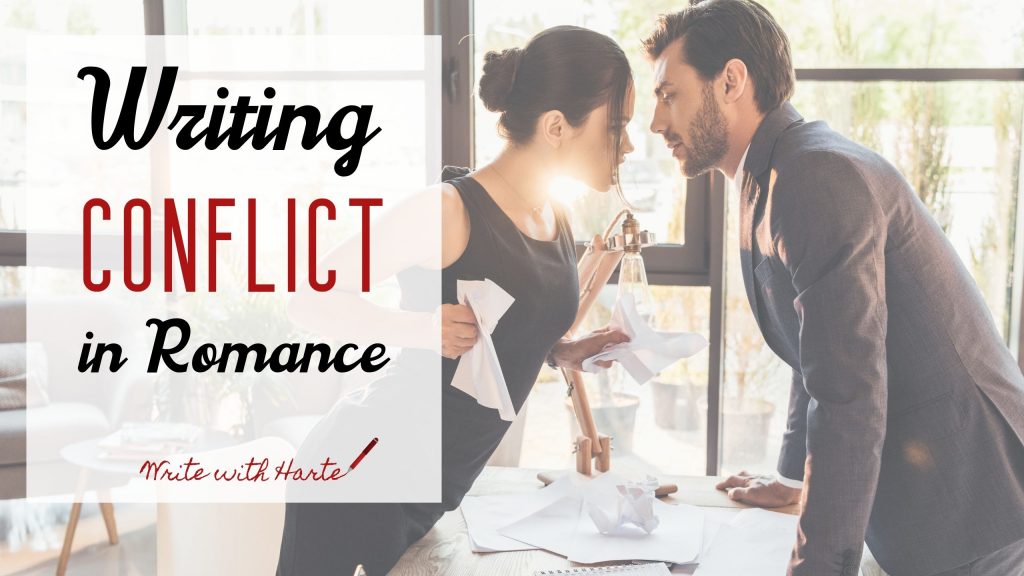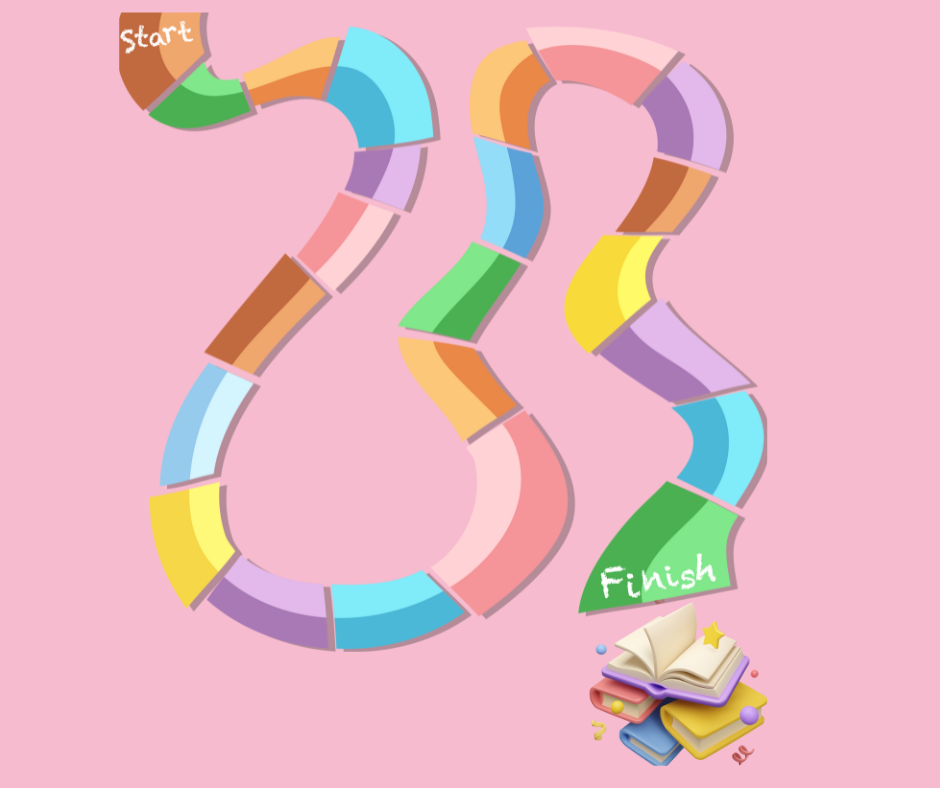Conflict in Romance

I was at the C3 Conference in Maryland in 2019, on a panel about romance and we were asked about whether or not a battle of the sexes was required in a romance. One of my fellow panelists said, “Yes, because that’s where the conflict comes from in the story.”
Being contrary, I disagreed and said that while yes, conflict is needed in a romance (or any story), it doesn’t necessarily have to be between the couple.
In the video below, I provide all the different options for conflict in a romance.
What are your thoughts on the matter? Can you have a worthwhile romance when the conflict is not between the couple?
Transcript of the video is below.
TRANSCRIPT
Note this is a very rough transcript of the video.
Hey, writers, welcome to another episode of Write with Harte. Today, we’re going to talk about conflict in romance and whether you need to have a battle of the sexes in order to make a really good, interesting romance.
So this last weekend, I was at the C3 conference, and I was on a panel called the Battle of the Sexes, where we were talking about conflict and romance. One of the questions the moderator asked was whether or not it was a requirement to have conflict between the couple in a romance and one of my panelists said yes, that that was sort of the nature of a romance. A romance was about a couple coming together in a battle of wills, working things out until they finally, at the end, realize that they want to be together and they live happily ever after.
I, being contrary, said no, you do not have to have your conflict between the couple to make a really good romance. Now thinking about it, that doesn’t make any sense because obviously conflict is where a lot of interesting things take place in a novel. So I wanted to go ahead and explain why I had an alternative view of conflict between the couple and whether you needed it.
First of all, you do need conflict in a story. Conflict is really where the story takes place. If you just had two people holding hands and having a good time, that’s not a very interesting romance. So yes, absolutely, conflict needs to be in a romance, but it doesn’t necessarily have to be between the couple. So if you have to have conflict in romance, but you don’t have to have it between the couple, where can conflict occur?
I wanted to go over some of the different ways that you could put conflict in your romance, including between the couple as well as other alternatives. And of course you don’t have to have just one source of conflict, as we’ll see when we talk about some specific romances that you can refer to sometimes there’s more than one source of conflict in a romance novel.
So first of all, let’s talk about conflict between the couple, which is extremely popular. You see it a lot. It’s in the opposites attract or enemies to lover type novels. It’s in any case in which the goals of your protagonist, your couple come into conflict with each other. For example, maybe they both are going after the same promotion or maybe one is trying to do something that the other one is trying to stop. Whenever you have a couple who have a conflicting agenda, have conflicting goals or goals that are in opposition to each other, that is, when you have conflict between your couple.
Sometimes this just occurs because for whatever reason, they don’t like each other, and we actually see that quite a bit. It’s very common for the couple to be at odds with each other, for whatever reason, they just can’t get along.
However, there are many romance novels where that is not the case and I want to go ahead and talk about a few of them. Another source of conflict is one that comes from outside the couple. The couple can get along really well, but for whatever reason, there’s something going on outside of them that is getting in the way of their being able to express their love or to be a couple. A very common theme in this type of romance would be social constraints. Things that are happening in society. Social norms that prevent them from being together.
One of the most popular romances, and in fact I think it’s considered one of the early domestic romances is Pride and Prejudice, written by Jane Austen. Many of the romances you will read from the 18th and 19th century include this social constraint, social norms getting in the way of romance. The reason is because at that time social economic status was important. It was something people wanted to retain. There was a looking down on people that didn’t have as much money as you.
You also have to remember that women during that time generally couldn’t own property. They couldn’t work. They were not the boss of their own body, so to speak. And so, they were really at the whims of the decisions their parents made. And then of course they would get married and whatever their husband said went. So very strong social norms and social rules that are dictating the time to indicate what was allowed and not allowed.
In Pride and Prejudice, the actual initial conflict is between the couple. Because Elizabeth overhears Darcy saying something not very nice about her, so she decides he’s just a pompous snob and he’s full of pride. And of course she carries a prejudice about this. So everything that she hears about him is filtered through this idea that he is a pompous snob. But eventually that turns around. When Darcy first makes his initial proposal to her, he does a very bad job of it because basically he saying your family is beneath me, and they’re an embarrassment to the world, but I love you anyway and I want to marry you now. Of course, Elizabeth doesn’t take this very well. She turns him down.
But in that proposal, he indicates a social constraint. He is saying that society would look down on the match between them because her family is beneath him and they’re a little bit silly, and despite that, he’s willing to toss that aside because he loves her. Eventually they come around. Elizabeth realizes he’s not the pompous ass that she thinks he is. He’s just socially inept and eventually they begin to develop a relationship. And we know that Darcy’s willing to throw aside the social constraint that says she’s not good enough for him. So all is well, right? Well, no, because Lydia, Elizabeth’s little sister runs off with Wickham. This creates a gigantic problem because not only does it ruin Lydia’s reputation, but it ruins the reputation of the family. And now all the girls in the Bennett family are unmarriageable. Nobody’s going to want them because she has tainted the family and it is a constraint that Darcy really cannot overcome. So here’s society, keeping these two would-be love birds apart.
Fortunately, Darcy is clever and he’s resourceful and he’s able to fix things up to cover up what Lydia has done. He gets Wickham and her married so now that they are reputable, and they’re salvaged and now he and Elizabeth can be together. This is an example of Elizabeth Darcy at the end are getting along. It looks like they will be together, and society comes in and says not so fast.
Now when it comes to social constraints, a lot of times it can be related to socioeconomic status, but not always. Anytime society is stepping in and saying, “That’s not the norm. That’s not right.” You can create a social construct that gets in the way. So for example, interracial marriages. Or in the case of some sort of paranormal or sci-fi fantasy, you could have an interspecies relationship, for example, in a Discovery of Witches, Diana is a witch. Matthew is a vampire. It is against the law for them to be together. They do it anyway. So going against society, having a social conflict isn’t just about money and status. It can be any sort of social rule that can get in the way of a couple being together.
Another example of a conflict that can occur outside the couple would be danger. So romantic suspense, a romantic mystery, some sort of adventure. Maybe they’re stuck in a blizzard. Anything that is outside them that puts them in danger, puts them in harm’s way can be a source of conflict for them. It could be sort of them against the world as they’re trying to save the world or try and find a bad guy or try to avoid the bad guy. That kind of conflict can also occur. Those are some of my favorite types of romances. I really enjoy romantic suspense and romantic mystery. I like to have a couple that is working together to achieve a goal. And again, you can still have the situation in which maybe there’s conflict between them. Maybe they’re forced into trying to work together, even though they don’t like each other, but that’s not always the case. They can be getting along and trying to save the world.
And of course, whenever there’s danger involved, the risk of losing the other person that you have fallen in love with can become a major source of conflict.
So we’ve talked about that there’s conflict that can occur between the couple. We’ve talked about, conflict that can occur outside the couple. Now let’s talk about conflict that can occur up in the couples’ mindset. The way that they think about the world, the way they view themselves, view the world, view the other person can be a source of conflict. We see this quite a bit in the trope of friends to lovers. Now here is a couple that like each other. They are friends. In the course of the book, they are friends with benefits often. So where’s the conflict if they’re getting along? They’re having a good time. Where’s the conflict? Generally, it occurs in something that they are thinking about themselves or about the relationship. An author that I really enjoy that does this well, as Lauren Blakely. Almost all of her books involve a couple that are getting along. They are friends, sometimes they’re coworkers or business partners or something, and they decide there’s a multitude of reasons why they might end up getting together. In some cases, one needed a fake fiancé. Sometimes they end up being roommates. There are all sorts of things that kind of bring them together. But through the whole course of the book, they’re having a good time. They’re not fighting. They’re not at odds with each other and yet it is their thinking that is getting in the way, because slowly they are falling in love. But they are mindful of the fact that this is just a friends with benefits. Or maybe there’s some sort of deal that they’ve made, you know, we’ll do this for a month and then one is going off to do a job somewhere else or something, and they don’t want to mess that up. They feel like if they admit their feelings, that the other person will either reject them and then they’ll look foolish and maybe ruin the friendship.
So generally what is getting in the way, is their own self. Through the course of the book, it’s them learning to trust the other person with their feelings and how they’re feeling and taking a chance on that. And one of the things I find most interesting about many, if not most, of Lauren Blakely’s books is that often the black moment isn’t really that black, you know? In a lot of romances, the black moment separates our couple. They have a big fight, and they break up or, one is kidnapped, and it looks like they’re going to be killed.
In Lauren Blakely’s books a lot of times, that moment isn’t that big, and yet it is still very satisfying when they come up against the point of no return, they either have to confess how they’re feeling, or let the whole thing go. And it’s still quite satisfying. Part of it is her writing style. She writes in first person present, so you’re very much immersed into the book as it’s taking place. She also just has a really sort of fun way of writing. There’s a lot of humor. If you haven’t read one of her books, I do encourage you to do so. They do have a lovey bits in them, so if you’re more of a sweet romance reader, it might not be a good fit for you. But in terms of reading a friends to lovers type romance that doesn’t have a lot of angst and drama, she has some really good choices.
Another thing that can get in the way are personal beliefs. I see this a lot in Sandra Brown’s romantic suspense books. Now, of course, we do have a danger and drama that takes place in those, but she tends to write these really gritty, almost unlikable, kind of on the verge of unlikable male protagonists. They are really rough and gruff, and generally they are unable to help themselves in terms of wanting to be with the women, even though they’re kind of telling themselves that that’s not a good idea. But they also have this idea that they’re not good enough for the woman. So, when the all the drama and all the action and all the danger is done a lot of times they end up leaving. And it isn’t for a couple of weeks, sometimes it’s a couple of months that they either decide to come back or a lot of times the woman hunts them down and says yeah, you are good enough. So again, that’s another factor in which some sort of inner conflict is taking place that is getting in the way of the couple being together.
My final question and the thing that I brought up on the panel was this idea that for some reason, a couple that was happily together was no longer interesting. And that idea is perpetuated because a lot of times on, especially in TV shows, where they have the “will, they or won’t they” get together type of thing going on. When they finally get together, it does sort of get boring. But in my mind, that’s poor writing, not that a romantic couple can’t be interesting. Because there have been situations in which there are interesting couples who are together. Hart to Hart was a passionate, romantic couple, they rarely ever fought, yet they were so fun to watch. Bones had a couple that eventually, it took them forever, got together and I thought they continued to be pretty fun. They ended up having a couple of kids.
So there are ways to keep stories and conflict interesting while still having a couple that is happily together. It is something that I do in the Valentine mysteries. At least I hope that’s what I’m doing. My goal is to have a passionate, happy couple that the conflict is almost always them trying to solve a crime. Now, throughout the Valentine mysteries, in the early books, there is more conflict between them, but that’s because their relationship is evolving. That is normal in a relationship as they learn to grow together and learn how to be together. But in the later books where their marriage is pretty solid. that conflict between them is much less. And yet I still feel like they’re pretty fun. It’s like them against the world as they go out and try and live their lives and continually, accidentally stumble on dead bodies.
So what do you think? Do you think it’s possible to have an interesting romance without having your couple be engaged in a battle of wills? Or do you prefer that? Do you prefer your romantic couple to be butting heads through the course of the book?
I would be curious about your thoughts below. Or maybe you have some other ideas about where conflict can come into romance that I haven’t yet mentioned. Or maybe some book ideas that you would recommend that highlight different ways to have conflict without it necessarily being between your couple.






Responses